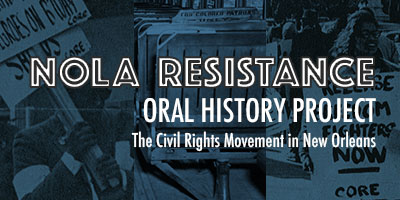

The modern African American civil rights movement brought about immense cultural change in New Orleans. The fight for racial justice included voter registration drives as well as efforts to end segregation and curtail discrimination in schools, on public transportation, and in businesses. Local chapters of CORE, the NAACP, and NAACP youth council led the movement.
This oral history project, funded in part by a National Park Service grant, records testimony from individuals who were active in the fight for racial equality in New Orleans between 1954 and 1976. For more information, access the full audio and transcript for each oral history.
The project documented a number of historic events and themes in the interviews with the activists who took part. The ten short videos below highlight these stories from the civil rights movement in New Orleans.
View all material in the series
Lesson Plans
This curriculum, based on oral histories collected as part of the NOLA Resistance project, prompts students to engage with primary and secondary historical sources to examine the experiences of local civil rights leaders. The three lessons—Stories of Resistance, Young Leaders of New Orleans, and Integrating McDonogh 19—help students cultivate critical thinking skills, further develop their reading comprehension abilities, and gain experience in assessing different types of historical sources.
Featured Stories
Public School Integration
In November of 1960, six years after the US Supreme Court’s ruling in Brown v. Board of Education found segregation by race in public education to be unconstitutional, New Orleans’s public schools began the process of integration. That fall, four young girls—Leona Tate, Tessie Prevost, Gail Etienne, and Ruby Bridges—integrated two elementary schools in the Ninth Ward, McDonogh 19 and William Frantz.
The Freedom Rides
During the early 1960s, civil rights fighters pushed for enforcement of the federal ruling to provide integrated facilities for interstate travel by organizing bus trips known as “Freedom Rides.” New Orleanians, including members of the local CORE chapter, trained riders and boarded buses as part of the effort. Dodie Smith-Simmons recalls her experiences as a Freedom Rider, including the day when a colleague told her to “get Bobby Kennedy on the phone.”
The Castles, Freedom House and Dooky Chase's
The Castle family, including Oretha and her sister Doris Jean, were leaders of the local civil rights movement. Their family home, dubbed “Freedom House,” served as a place for visiting freedom fighters to meet, plan, eat, and rest. Dooky Chases’s Restaurant, where family matriarch Virgie Castle worked, provided food to demonstrators and a place for leaders of the movement to convene.
The Canal Street Boycotts
Throughout 1960 and ’61, demonstrators protested unequal hiring practices and services for African-Americans at Canal Street businesses. Dr. Raphael Cassimere Jr., then a leader of the local NAACP Youth Council, recalls these efforts.
March on City Hall
In 1963, local civil rights leaders from across the city came together to organize a march on city hall. An estimated 10,000 protesters from across the city, and from many different organizations, participated in the protest.
/p>
New Orleans Congress of Racial Equality (CORE)
The local chapter of the Congress of Racial Equality (CORE) was one of the most active groups in the city and region during the early 1960s. Led in large part by students and young activists, New Orleans CORE participated in nonviolent direct action protests and registered voters across the city and state.
Voter Registration
Registering African American voters was a key mission of the civil rights movement. Many local organizations worked to expand the electorate to include those previously affected by the de facto disenfranchisement of black voters that was a central element of the Jim Crow South.
Music in the Movement
Civil rights fighters often used group singing to fortify and unite themselves in the face of dangerous work. Much of the repertoire borrowed from spirituals, offering messages of hope and inspiration through music.
Confronting Segregated Spaces
For African Americans, living in Jim Crow New Orleans meant facing dehumanizing racial segregation and degrading personal interactions on a daily basis. Confronting these inequities head on was one of the many ways civil rights fighters pushed back.
The Showdown in Desire
In the fall of 1970 the offices of the local chapter of the National Committee to Combat Fascism, an offshoot of the Black Panther Party, were violently raided by the New Orleans Police Department. Following the confrontation, organization members were arrested and placed on death row. Malik Rahim describes his experience during and after the episode.
This material was produced with assistance from the African American Civil Rights grant program, administered by the National Park Service, Department of the Interior. Any opinions, findings, and conclusions or recommendations expressed in this material are those of the author(s) and do not necessarily reflect the views of the Department of the Interior.
